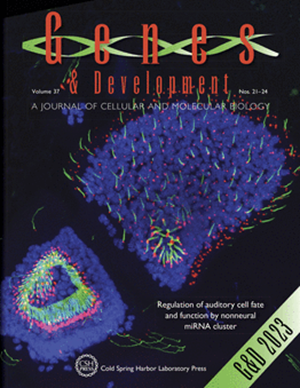一个动力学尺子控制mRNA poly(A)尾巴长度
IF 7.7
1区 生物学
Q1 CELL BIOLOGY
引用次数: 0
摘要
新合成的mrna的聚(A)尾部具有均匀的长度,这是由裂解和聚腺苷化复合物(CPAC)和聚(A)结合蛋白(PABPs)共同作用产生的。在出芽酵母酿酒酵母(Saccharomyces cerevisiae)中,负责的PABP是进化保守的CCCH锌指蛋白Nab2,它促进了约60个腺苷mRNA poly(A)尾巴的生物发生。在这里,我们讨论这种长度控制的分子基础。在体外重构Nab2:poly(A) RNA核糖核蛋白颗粒形成过程中的聚腺苷化反应,我们发现Nab2二聚化指导聚腺苷化终止。Nab2二聚体仅在含有25个腺苷的聚(A)尾部稳定,这解释了Nab2如何避免过早终止聚(A)合成。然而,成熟的尾巴长度不是由Nab2在RNA上的足迹决定的,而是由cpac介导的尾巴伸长和Nab2 RNA结合之间的动力学竞争决定的。Nab2 RNA结合率的变化可以改变poly(A)尾长度,但在细胞中,这种变化被Nab2蛋白浓度的自动调节所缓冲。因此,poly(a)尾部长度控制通过一种“动力学尺子”机制运作,即Nab2的浓度量化RNA长度。本文章由计算机程序翻译,如有差异,请以英文原文为准。
A kinetic ruler controls mRNA poly(A) tail length
Poly(A) tails of newly synthesized mRNAs have uniform lengths, arising through cooperation between the cleavage and polyadenylation complex (CPAC) and poly(A) binding proteins (PABPs). In the budding yeast Saccharomyces cerevisiae, the responsible PABP is the evolutionarily conserved CCCH zinc finger protein Nab2 that facilitates the biogenesis of ∼60 adenosine mRNA poly(A) tails. Here, we address the molecular basis for such length control. Reconstituting polyadenylation reactions during the formation of Nab2:poly(A) RNA ribonucleoprotein particles in vitro, we found that Nab2 dimerization directs polyadenylation termination. The Nab2 dimer is stable only on poly(A) tails that are >25 adenosines, explaining how Nab2 avoids prematurely terminating poly(A) synthesis. However, the mature tail length is not determined by the footprint of Nab2 on the RNA but rather by the kinetic competition between CPAC-mediated tail elongation and Nab2 RNA binding. Variations in Nab2 RNA binding rate can shift poly(A) tail lengths, but in cells such variations are buffered by autoregulation of Nab2 protein concentration. As a result, poly(A) tail length control operates through a “kinetic ruler” mechanism, whereby the concentration of Nab2 quantifies RNA length.
求助全文
通过发布文献求助,成功后即可免费获取论文全文。
去求助
来源期刊

Genes & development
生物-发育生物学
CiteScore
17.50
自引率
1.90%
发文量
71
审稿时长
3-6 weeks
期刊介绍:
Genes & Development is a research journal published in association with The Genetics Society. It publishes high-quality research papers in the areas of molecular biology, molecular genetics, and related fields. The journal features various research formats including Research papers, short Research Communications, and Resource/Methodology papers.
Genes & Development has gained recognition and is considered as one of the Top Five Research Journals in the field of Molecular Biology and Genetics. It has an impressive Impact Factor of 12.89. The journal is ranked #2 among Developmental Biology research journals, #5 in Genetics and Heredity, and is among the Top 20 in Cell Biology (according to ISI Journal Citation Reports®, 2021).
 求助内容:
求助内容: 应助结果提醒方式:
应助结果提醒方式:


